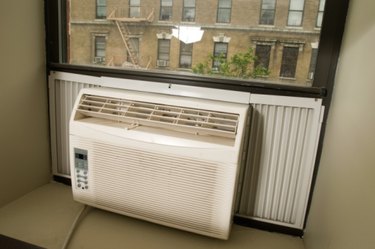Things You'll Need
Toothbrush
Mold and mildew remover in spray bottle
Garden hose
Wet/dry shop vacuum
Screwdriver
Hairbrush
Carpenter's level

Unusual odors coming from window air conditioner units often result from mold growing on damp surfaces. Coatings of dust and dirt provide a perfect medium for the fungi that cause unpleasant smells. Mold spores could also cause allergic reactions and asthma. Regular cleaning prevents dust and dirt from building up on filters and coils and slows mold growth. Regular maintenance also keeps the unit working properly, taking the strain off the motor and extending the air conditioner's lifetime.
Step 1
Unplug the air conditioner's power cord and remove the unit from the window. Place the air conditioner in a location outdoors where soap and water won't cause problems.
Video of the Day
Step 2
Remove the front air filter cover. Most air conditioner filter compartments open by pressing up or down on the cover, freeing the locking tabs from the housing. Covers could come entirely off or swing out on hinges.
Step 3
Grasp the tab on the front panel's air filter and pull it out of the machine. Use a toothbrush to sweep the loose dust and lint from the filter's screen. Spray the filter with mold and mildew remover and brush again lightly with the toothbrush. Rinse the filter clean and set it aside to dry.
Step 4
Check the screen behind the filter for dust and dirt. Sweep accumulations loose with the toothbrush. Vacuum the screen clean. If the dirt won't come loose, spray with cleaner and brush again before cleaning with the shop vacuum.
Step 5
Find the screws that hold the air conditioner cabinet to its frame, usually located along the edges of the cabinet housing. Use the screwdriver to remove all the screws and then lift the cabinet off the air conditioning unit.
Step 6
Spray the condenser coils and fins with the cleaner and brush carefully with the hairbrush or toothbrush to loosen mold and dirt. Rinse clean with water and repeat where necessary.
Step 7
Check the bottom pan of the air conditioner for dirt and debris. Clean and rinse as needed. Check the drain hole in the rear of the unit to be sure nothing blocks the opening.
Step 8
Check the interior of the cabinet for dirt and mold. Spray problem areas and brush lightly, then rinse with clean water.
Step 9
Let the air conditioner dry before re-attaching the cabinet and replacing the front filter and filter cover.
Tip
Use a light touch to avoid damaging filters, screens, and fragile metal parts. Reusable foam filters clean up easily with plain soap and water in the kitchen sink, says Saturn Resource Management. Bathroom cleaners formulated for mold and mildew removal on bathroom fixtures also work well on air conditioner parts. These cleaners include detergents for loosening and removing dirt as well as disinfectants that kill fungi and bacteria. Cleaning front filters -- which doesn't require removing the entire unit -- increases efficiency from 5 to 15 percent, according to Energy Savers.
Warning
After re-installing the unit in the window, use the carpenter's level to make sure the air conditioner tips slightly to the outside. The unit must tip toward the rear for the bottom drain to work properly, says NYC.gov.
Video of the Day